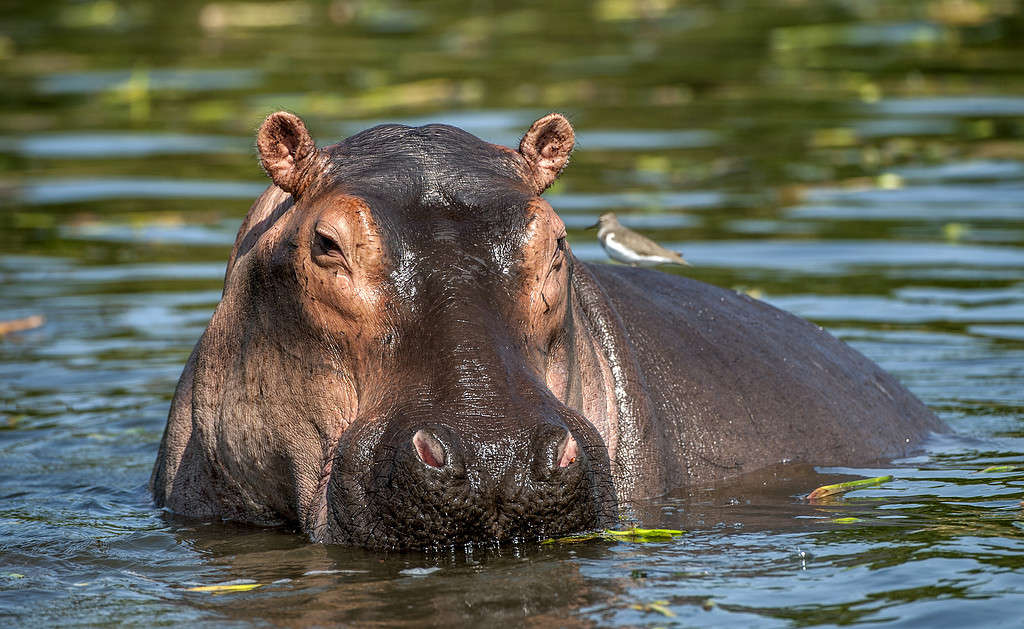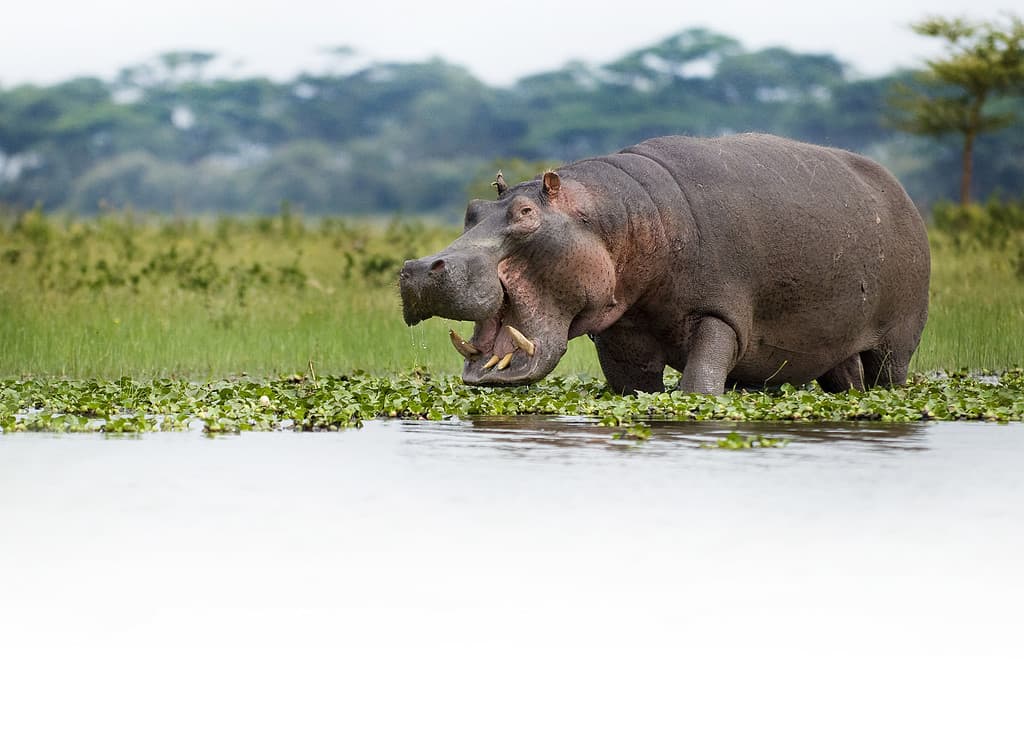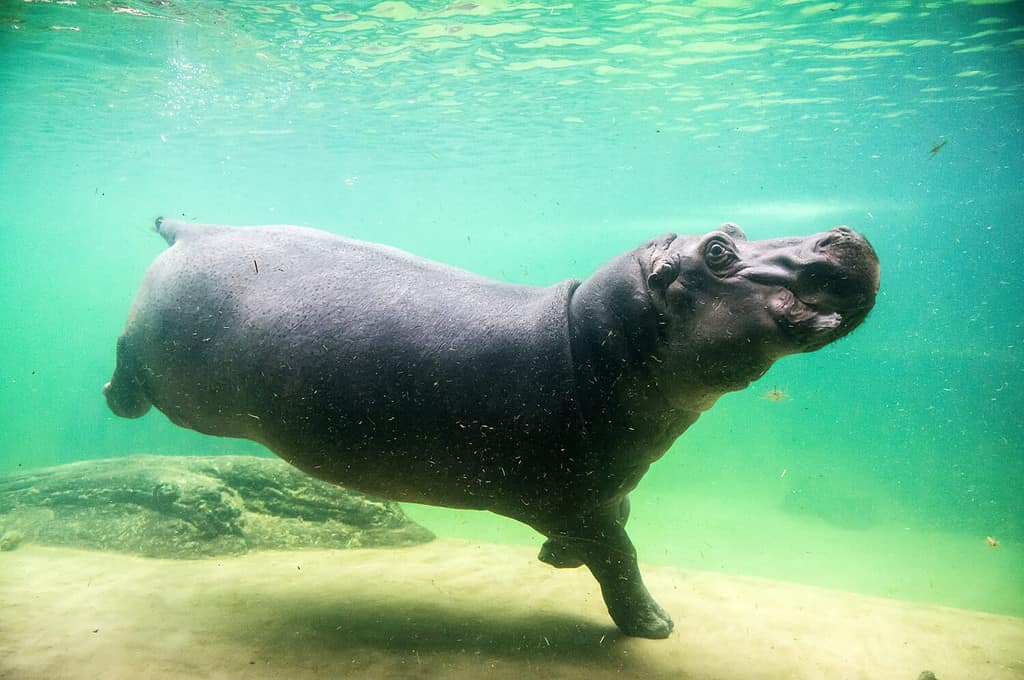The hippopotamus is a well-known animal. Some of its most distinctive features are its enormous size and jaws. Hippos can grow up to 16 feet long and weigh more than four tons! The teeth inside their impressive jaws can grow up to 20 inches long and can be helpful in a fight. However, there is another feature that the hippopotamus is often recognized for, which has nothing to do with their teeth. In this article, we are talking about the other end of the hippo, the rear end. You see, the hippopotamus displays an interesting behavior when relieving itself; it sprays its poop around like it is a sprinkler. In this article, we will dive into all things hippos and answer why they spray their poop like a fast sprinkler.

The common hippo is most commonly found in the deep and slow-moving rivers and lakes in eastern and southern countries.
©iStock.com/Sergei Uriadnikov
Why Do Hippos Spray Their Poop Like a Fast Sprinkler?
Hippos are great at communicating with one another. They use a sound called a “wheeze-honk” to communicate with each other. Although zoologists and wildlife experts knew it was some method of communication, the true meaning behind it was recently discovered. There are three types of hippo calls: one that comes from a hippopotamus that belongs to their group — known as bloat —one from a hippopotamus of a neighboring bloat, and one from a hippopotamus of a distant bloat.
Regardless of the call, the hippos always responded by vocalizing their wheeze-honk, approaching the sound, or spraying dung. However, a study conducted by Nicolas Mathevon — an acoustic communication researcher — demonstrated that the intensity of these responses was far more remarkable when the call came from an unknown hippo. These findings indicate that the hippopotamus sprays its dung as a territorial marking behavior, signaling to stranger hippos from other bloats that they are approaching their territory. They use their wheeze-honk to signal that a stranger is approaching their herd and then assert their dominance and territory by spraying their poop like a sprinkler.
Facts About Hippo Poop
Here are three quick facts about the hippo’s bowel movements and their oh-so-famous poop.
- In one day, a single hippopotamus can generate around 400 pounds of waste.
- Hippo poop — when it builds up — cuts off oxygen levels and leaves behind chemicals that can be harmful to wildlife, such as fish.
- To help spread their poop — and signals — far and wide, the hippo will use its tail as a propellor to fling the poop around it. They do this by wagging it vigorously to have their feces spread wide, marking their territory.
Hippo Basics

The hippopotamus is a herbivorous animal; different species of grasses are their main food source.
©TheBionicDan/ via Getty Images
The hippopotamus (Hippopotamus amphibious) is a well-known, semi-aquatic mammal found wallowing in the rivers and lakes across sub-Saharan Africa. While they may appear cute and cuddly, these mammals are one of the most dangerous animals in Africa. Besides not wanting to get near the hippo because of their habit of spraying their poop like a sprinkler, you may want to avoid close contact with these animals because they have a track record of harming humans. About 500 deaths per year to humans in Africa are because of hippos. Below is some basic information about this incredible yet deadly animal.
Characteristics
The common hippo has a large, grey, barrel-shaped body. This species usually measures about 16 feet long and weighs over 2,000 pounds. They have strong jaws and teeth that are useful in fights. These hippos spend a great deal of time in the water and have a variety of adaptations — such as webbed feet — to allow them to do so.
The pygmy hippo also has a long, barrel-shaped body but is much smaller than the common hippo. The pygmy hippo only reaches about 5 feet long and weighs over 300 pounds. It is the smaller species of the two. Also, the head of the pygmy hippo is smaller in relation to its body, and it has a more narrow mouth. These adaptations allow them to move more quickly on land, which is ideal because they spend more time on the ground than in the water.
Habitat
The common hippopotamus inhabits Africa, specifically south of the Sahara. This hippo spends most of its time in the water, always near a water source. Additionally, they prefer areas close to grasslands so they can feed during the night. This species also dwells in the seasonal wetlands.
The pygmy hippopotamus resides in Liberia and Cote d’Ivoire in western Africa. Additionally, some small populations exist in Sierra Leone and Guinea. Unlike the common hippopotamus, this species spends more time on the land than in the water. These hippos inhabit dense, lowland tropical forests and swampland.
Hippo Adaptations
The common hippo has many adaptations that help it to survive in its environment. Their eyes, nostrils, and ears — which are located high on their head — enable them to hear and breathe while almost completely submerged in the water. This adaptation helps them with cover and blending in. Additionally, their webbed feet and body proportions allow them to move quickly in the water — where they spend most of their time.
Also, pygmy hippos protect their thick skins from getting burned by secreting a reddish substance through their glands, which acts as a sunscreen. That is another reason hippos stay in the water for extended periods; apart from cooling off, it also hides them from the unrelenting sun.
The above adaptations are in addition to the communication calls they can do above and below the water. Also, hippos spray their poop — also referred to as muck-spreading — to mark territory. This hippo is well-adapted to its environment.
The pygmy hippo also has various adaptations that suit its environment well. Its smaller head, body size, and narrow mouth allow it to move more quickly through the forest — which benefits them, seeing as they spend most of their time on land. Additionally, they have fewer webbed toes than the common hippopotamus, to help them move more efficiently on land. Their eyes are also on the side of their head, rather than the top, to help them see more among the trees.
Different Hippo Types

The pygmy hippopotamus is nocturnal and forages in the forest at night for various plant matter and fallen fruits.
©Alfonsopazphoto, CC BY-SA 3.0 <https://creativecommons.org/licenses/by-sa/3.0>, via Wikimedia Commons – License
Not all hippos are the same; there are two species of the hippopotamus. Those species are the common hippopotamus (Hippopotamus amphibious) and the pygmy hippopotamus (Choeropsis liberiensis). While these two hippos may appear similar in specific characteristics and behaviors, there is a lot that distinguishes them as well. The table below summarizes the main differences between the two species of hippopotamus.
| Category | Common Hippopotamus | Pygmy Hippopotamus |
|---|---|---|
| Size | 6.5-16.5 feet long 2,200-9,900 pounds | 5-5.5 feet long 350-600 pounds |
| Coloring | Brown, grey, black, or pink skin | Pink, light grey, or dark grey skin |
| Social Activity | A social animal | Solitary behavior |
| Population | 148,000 Is considered vulnerable | Less than 3,000 Is considered endangered |
| Habitat | Lakes, rivers, and wetlands | Hot, lowland rainforest and swampland |
| Top Speed | 30 mph | 18.6 mph |
| Most Distinguishing Feature | Ears, eyes, and nostrils on top of their head | Webbed toes and barrel-shaped body. |
5 Interesting Facts About Hippos
Here are five interesting facts about these incredible animals.
- Hippos are most closely related to whales. The two are thought to have had a common ancestor that existed roughly 54 million years ago.
- The common hippo has pink anti-bacterial sweat!
- Hippos are some of the deadliest animals in Africa, killing at least 500 people a year.
- Hippos cannot swim! That’s right; although they spend much time in the water, they do not swim. They do more of a galloping motion through the water.
- Hippos eat more than 60 pounds of food at night!
Hippo FAQs

Despite spending the majority of time in the water, hippos cannot swim. Instead, they do a gallop-like motion along the bottom of the water source.
©Lena Ivanova/Shutterstock.com
Do hippos poop to mark their territory?
Yes, hippos use their poop as a way to mark their territory. The hippos spray their poop like a sprinkler to let other hippos know that that area belongs to them. The process is referred to as “muck-spreading,” it serves as a maker to that hippo’s bloat and to other bloats that this is their turf.
Why is hippo poop toxic?
Frequently, hippos defecate in the water. When that poop builds up, it can become toxic to wildlife, such as fish, because it cuts off oxygen levels and leaves behind chemicals that could be harmful, such as methane and ammonium.
How aggressive are hippos?
Hippos are a very aggressive species. They are known to attack lions, hyenas, crocodiles, and humans! Their tusks and sharp teeth make them animals that you do not want to have an altercation with. However, most of their aggression comes from being territorial, so if you stay away from areas they deem their territory, you should avoid experiencing their aggression.
What animals eat hippos?
Big cats such as lions and other animals like hyenas and crocodiles are the most common predators of the common hippopotamus. Also, people pose a threat to hippos because of hunting and the loss of their natural habitats.
The pygmy hippopotamus has to fear leopards, wildcats, and pythons as their predators. Similarly to the common hippopotamus, they also need to fear humans.
Are hippos dangerous to people?
If you get too close to a hippo’s territory, they are dangerous to humans. It is considered by many to be among Africa’s most dangerous mammals, and attacks on people are not unheard of. Most hippo attacks happen to people on boats because they are in the hippos’ territory. They are known to kill at least 500 people a year.
Why do hippos open their mouths?
Hippos use their mouths as a communication tool. They can display warnings, friendly gestures, or hierarchical relevance with their mouths.
How long can hippos breathe underwater?
Hippos cannot breathe underwater. They are mammals that have lungs and need to breathe air. However, they can hold their breath underwater for as long as five minutes. Young hippos need to surface more often.
The photo featured at the top of this post is © iStock.com/curioustiger
Thank you for reading! Have some feedback for us? Contact the AZ Animals editorial team.






